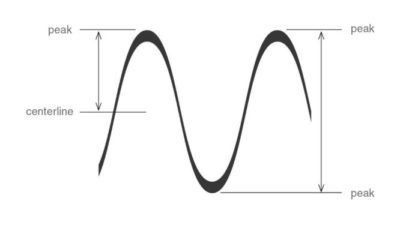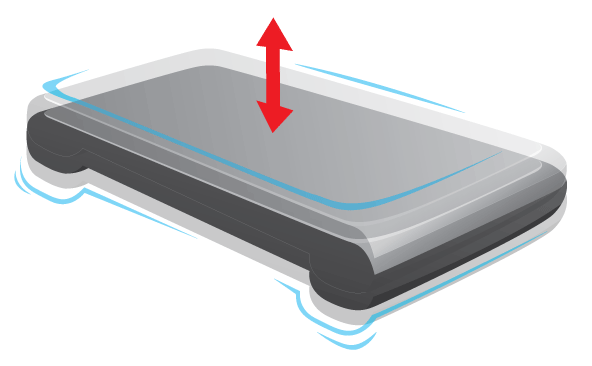Whole Body Vibration Forum
There are many companies selling vibration machines, and some machines are sold by many different distributors under different names, sometimes for widely varying prices, and everybody says their machine is the best! It can be very hard to know which one is right for you. Click here for comparison listing of different brands of WBV machines.
Gravitational (g) Force, Amplitude, and Frequency:
The power of a machine (g-force) is determined by the amplitude (the distance the plate moves), the frequency (the rate or speed of vibration), and the weight of the person on the plate. The greater the amplitude, the frequency, and the weight, the greater the g-force. Imagine putting your hand on a purring cat versus holding a jackhammer—these are very different experiences because of the different amplitudes and weights involved, even though the frequencies of vibration are similar.
G-force is a popular and handy way to compare machines, though it is not an exact method, as the weight of different people varies significantly, and this is also a factor in determining g-force. Changing the amplitude dramatically changes the g-force; with a low amplitude vibration feeling like the purring cat versus high amplitude machines that can rattle your body with their more jackhammer-type vibration. To change the amplitude, one usually needs to change machines.
G-force and amplitude have become a hot topic, with many consumers searching for high numbers. This market pressure has led to some companies artificially inflating g-force and amplitude numbers. It is like women’s dress sizes—we get bigger, but dress sizes stay the same or go down . . . because that is what we want!
Buyers Beware: The latest confusing issue going on with vibration machines and the marketplace is companies using different methods to calculate the Amplitude specs for their vibration plates. In response to people thinking they need high amplitude, high g-force vibration machine and making buying decisions based on this factor, some companies now use a peak-to-peak measurement of amplitude versus the more standard center-line-to-peak amplitude measurement. Using the peak-to-peak-measurement method produces amplitudes suddenly twice as big as the center-line method, without actually changing the true vibration. Other companies deal with this issue by not posting amplitude information online at all. When amplitude information is posted online, there is no explanation or consensus as to which measurement is being referenced, so it is very difficult to know what you are getting with different machines.

Single Motor vs. Dual Motor:
A critical difference between machines is the number of motors producing the vibration.
Vibration machines were first developed (and are still best known) for their ability to create an intense workout. Many WBV-machine companies have the football mindset that the more power the better. Thus, many of the best-selling machines, and most of the machines you will find in health clubs and sports centers, are big, powerful, double-motor machines - a type of machine I do not recommend.
Most of us are not young, highly trained athletes - using these powerful machines with the average person, can be like a bull in a china shop. Ours is a football culture where more is better, but most of us are not football players. Just as you wouldn’t start a football training program at age sixty, or if you were young but had a neurological or skeletal muscular problem, you shouldn’t use these double motor machines, either.
Two motors producing vibration can also cause detrimental effects on brain and body synchronization, especially over time. Two motors can never be properly synchronized, as a result, if you stand on a two motor system, you and your brain can become desynchronized over time. This can lead to a host of negative side effects, such as, fatigue, muscle weakness, sleep disturbances and even immune system imbalance. A one motor system always delivers a 100% synchronized vibration and message to your brain and body, helping your system to be in its optimal functioning state.
High amplitudes and g-forces are not typically achieved using a single motor system, but all the beneficial effects of Whole Body Vibration can still be obtained, including increasing bone density and a fit, toned body. High amplitude and g-force is not the most important objective for WBV, even though some manufacturers promote this aspect of their machines.
Brain synchronization is the simultaneous, in-phase firing of brain cells across regions of the brain. These combined signals generate electromagnetic brain waves, which can be measured by electroencephalography (EEG) and magnetic resonance imaging (MRI). Because two motors can send a desynchronizing message into the nervous system, this can cause brain desynchronization.
There are also machines that have two motors operating two different types of motion, usually with the option of operating only one at a time. If you do use one of these machines be sure to only use one motor and motion at a time.
Becky's experience with a double motor WBV machine: When I first started WBV 20 years ago I was using a double motor vibration machine. After I had been using it about 6 months, during which time I did get stronger because vibration is an intense workout, I suddenly developed extreme muscle weakness, bone pain, multiple infections, and a return of my allergies, chemical sensitivities, digestive and nervous- system problems, among other issues. After a long period of trial and error, it became clear that the vibration was the cause of my sudden drastic downturn. It took me years to recover.
Eventually, I found vibration that sent a gentle and fully synchronized signal into my brain. With the aid of this type of vibration I eventually fully recovered. I have been using this type of vibration for fifteen years now, and I only get better—mentally and physically! The greater workout is not worth the risk. Do not use a double-motor machine.
Direction of Movement: There are two major types of motion for vibration plates: Vertical (or linear) and Oscillation.
Vertical, or linear vibration: These machines vibrate mostly up and down. This is the type of machine that I recommend for most people. As long as the vibration is produced with only one motor, this will provide a completely synchronized movement and message to your system, and this motion is the most stabilizing for your structural system. Confusingly, many variations of this first basic type of motion are produced by different motor configurations. Some types confer small amounts of horizontal motion and circular movement to the plate, along with a predominantly vertical motion.

To seem different (and better), companies come up with different names, such as three-dimensional, horizontal, spiral, circular, tri-planar, triangular, tri-phasic, multidimensional, omniflex, and piston. All these terms are describing basically the same type of motion. There is, however, a great variation in amplitudes, g-force, durability, and cost with these machines. (There are usually a range of frequency [speed] settings on any given vertical vibration machine, but these frequency ranges are generally similar between machines of this type).
The intensity of your vibration workout depends on the power, or gravitational force (g-force), of the vibration—a factor that takes into account the amplitude and frequency of the machine, and weight (your own weight) that your muscles must hold against the vibration. As amplitudes, frequency, and your weight all can vary greatly, there is great flexibility in the intensity of your workout. To get a sense of the effect of g-force, imagine putting your hand on a purring cat versus holding a jackhammer—these are very different experiences because of the different amplitudes and weights. A jackhammer’s amplitude of vibration, and its weight, are much greater than those of a hand resting on a purring cat, so even though the frequencies of these vibrations are similar, the total g-force, and therefore effect, is greater for the jackhammer.
Oscillation vibration: A second major type of vibration machine utilizes oscillation across a fulcrum in the middle of the plate, so that the plate rises and falls on either side like a child’s seesaw. This motion is called oscillation, pivotal, or teeter-totter (in scientific research papers, this motion is also sometimes called sinusoidal). These machines usually have greater maximum amplitudes but lower frequencies. They can provide a good workout and high g-forces for less cost. But the wild motion caused by essentially having a foot on each end of a rapidly moving seesaw can be destabilizing for your musculoskeletal system and stressful for your brain.
For ease of use and total health, I recommend a single-motor vertical-vibration machine with its perfect synchronization and smooth motion. While I believe that people of any age should avoid machines that create stress and/or destabilization, I feel it is extra important for the elderly and anyone whose health, including brain health, is more vulnerable.

